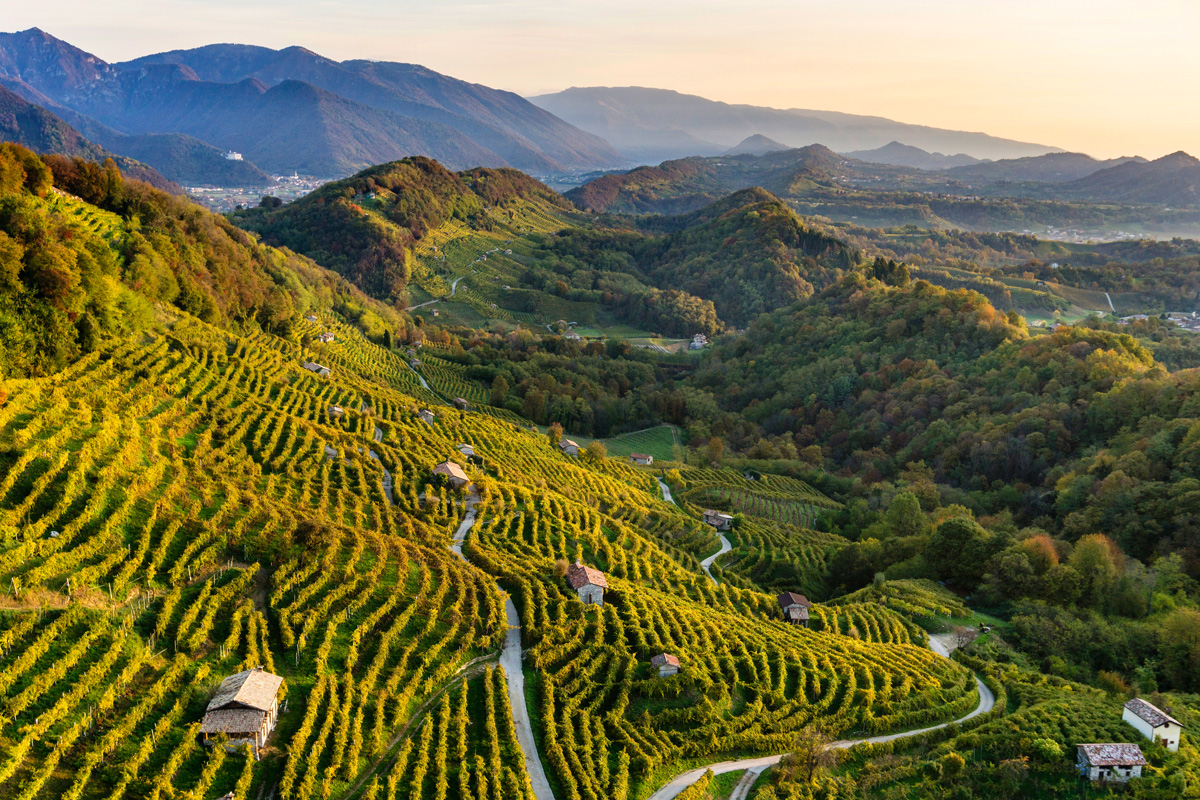
Wine Culture Magazine

UNESCO recognized not just the unique hogback vineyards of Conegliano Valdobbiadene, but its centuries of winemaking history. Arcangelo Piai photo
High above Italy’s Veneto region, the winemaking sisters of Sorelle Bronca, Antonella and Ersiliana, are showing me the lay of their land. As we climb the last few vertiginous metres of the vineyard, I experience a slight shortness of breath and realize just why this unique place is hailed for its “heroic viticulture.”
We’re in the Conegliano Valdobbiadene, the hilly region that produces the aptly named DOCG Prosecco Superiore. It was recently named a UNESCO World Heritage Site, a declaration that recognizes its historical importance and underscores its difference from its mass-produced DOC poor cousin below.
In contrast to the flat lowlands that satisfy the huge demand for cheap supermarket fizz, Conegliano Valdobbiadene’s hogback hills, known as “ciglioni,” produce the top tier wines of Prosecco. In fact, they account for just one in five bottles made. Typically, the sites are on slopes of 45 degrees or steeper, sometimes as precipitous as 70 degrees, and zig-zagged with narrow terraces of vines. It requires dogged dedication to grow the grapes that go into Prosecco Superiore, especially as up here, all is tended by hand. No vineyard mechanization exists aside from the rare funicular mini tram that hauls brimming bins up one impossibly steep vineyard. Pruning, training, thinning and harvesting are all performed manually, as they have been for generations.
The process to achieve industrial recognition as a World Heritage Site is an arduous one. In this case, it commenced well over a decade ago. Yet that period pales in comparison to the generations these hilly slopes have been worked, in many cases by the same families since the 1700s and earlier. Even the local church of Saint Pietro di Feletto, which dates from 1000 AD, features a fresco depicting implements associated with viticulture.
The UNESCO declaration serves to recognize and protect those numerous aspects of terroir.
They have never wavered in their belief in the uniqueness of our landscape, with its vineyard-embroidered hills and inaccessible slopes that require such hard and entirely manual labour.
“Right from the beginning, and throughout the entire nomination process, they have never wavered in their belief in the uniqueness of our landscape, with its vineyard-embroidered hills and inaccessible slopes that require such hard and entirely manual labour,” says Innocente Nardi, president of the Consortium for the Protection of Conegliano Valodbbiadene.
Of course, Congeliano Valodbbiadene is not the first wine region to be recognized as a UNESCO World Heritage Site. The entire City of Bordeaux, as well as parts of the Loire Valley and Middle Rhine are also on the heritage list.
More noteworthy is that the cultural landscape of Le Colline del Prosecco di Conegliano e Valdobbiadene was added very specifically for its human-shaped terrain and viticultural practices. In that it joins other unique viticultural areas such as Pico Island in the Azores, Hungary’s Tokaji (Europe’s first appellation) and Portugal’s Douro, as well as Piedmont’s Langhe-Roero and Monferrato regions, where, UNESCO notes, “Vine pollen has been found in the area dating from the 5th century BC, when Piedmont was a place of contact and trade between the Etruscans and the Celts.”
In great part due to their higher elevation vineyards, DOCG Conegliano Valdobbiadene wines tend to be more fruit driven and greatly benefit from increased natural ripeness, making them yet more distinct from the larger pool of DOC wines. It’s for this reason (and for many others) that Prosecco Superiore producers are placing more and more emphasis on the DOCG Conegliano Valdobbiadene place of specific origin and much less on the grape itself.
The UNESCO declaration enables the hilly region as well as its even higher-valued “Cartizze” wines to emphasize even more that critical point of difference.

Tim Pawsey writes and shoots at hiredbelly.com as well as for publications including Quench, TASTE and Montecristo. He’s a frequent wine judge and is a founding member of the B.C. Hospitality Foundation.

Tim Pawsey writes and shoots at hiredbelly.com as well as for publications including Quench, TASTE and Montecristo. He’s a frequent wine judge and is a founding member of the B.C. Hospitality Foundation.
Copyright © 2025 - All Rights Reserved Vitis Magazine